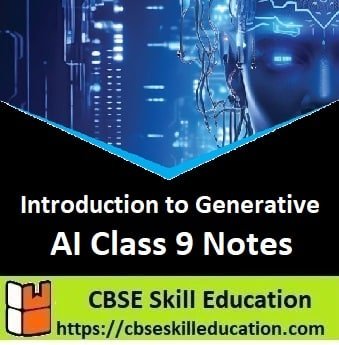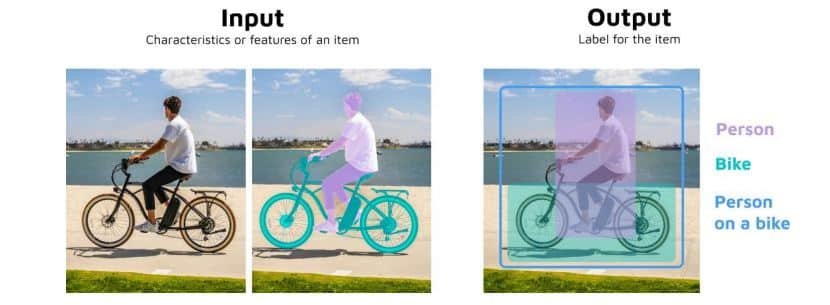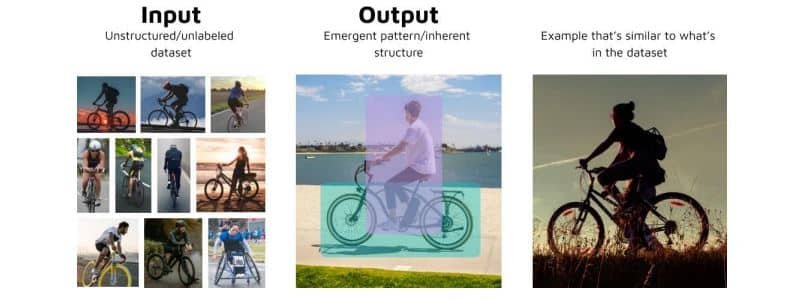Introduction to Generative AI Class 9 Notes – The CBSE has changed the previous textbook and the syllabus of Std. IX. The new notes are made based on the new syllabus and based on the New CBSE textbook. All the important Information are taken from the Artificial Intelligence Class IX Textbook Based on CBSE Board Pattern.

Introduction to Generative AI Class 9 Notes
What is Generative artificial intelligence?
Generative artificial intelligence is also known as generative AI. Generative AI is a type of AI that helps to create new content such as images, videos, music, and text. Generative AI can take input from the user in the form of text, image, audio, or video and generate new content based on the input given by the users.
Nowadays, creativity is an essential element for the progress and growth in various fields. Generative AI can generate new and unique content that can be used in business, schools, or any organization. Let’s see one image where the image is converted with the help of generative AI.

To understand the generative AI, first we have to understand how the machine learning model learns and how the machine applies its knowledge to generate desired output. We are going to discuss two concepts behind the generation of these images.
Supervised Learning and Discriminative Modeling
Discriminative modeling is used in machine learning algorithms, which are used in supervised learning. Supervised learning algorithms use labeled training datasets to find the outcomes. These datasets can initially be taught to machine learning models by humans.

In the above image, The classification of data elements into categories or labels was initially taught to the machine learning models by humans.
Unsupervised Learning and Generative Modeling
Generative modeling is also used in machine learning algorithms, which are used in unsupervised learning. The unsupervised learning algorithm helps to generate new data points without human intervention.

In unsupervised or self-supervised learning, the machine learning model takes unlabeled datasets and figures out patterns and inherent structures within them — without human intervention.
Benefits of using generative AI
The benefits of using generative AI are
- Content Writing – Generative AI is used to generate high-quality content or rephrase the sentence given by the users; this content is generated using natural language processing.
- Graphics design – Generative AI can be used to create marketing copy, graphic design, social media posts, etc. Generative AI can work with AI chatbots and generate new ideas for products.
- Analyzing Data – Generative AI can analyze large amounts of data for the companies using deep learning techniques to identify the market trends. It also helps the companies gain more confidence in their decisions and reduce risk.
- Cybersecurity – Generative AI can also help the network for security purposes. Companies can analyze large data to find the threats.
- Image/Video/Audio Creation – Generative AI can be used for generating new images based on specific artists, art styles, and scenarios given by the users.
- Research assistance – Generative AI trained on scientific data and helps researchers with their work; for example, medical researchers can use generative AI to develop new molecular structures.
Popular Generative AI tools and their applications
Generative AI tools are used to create content, images, and code. Some of the popular generative AI tools are
- ChatGPT – ChatGPT is a program that uses natural language processing to respond to the answer of the question request from the users. ChatGPT is trained on large amounts of text data and helps to generate text just like a human. Students can get help from ChatGPT, but one thing to remember is that some generative AI will not generate correct answers.
- Synthesia – Synthesia is AI powered based program which helps to create videos from the text. Synthesia uses AI to generate realistic avatars that speak, move, give facial expressions, and mimic the user’s voice. Synthesia offers over 230 avatars and more than 140 languages.
- AlphaCode – AlphaCode also uses generative AI to help the developers to write code, fix bugs, and suggest programming solutions.
- Murf – Murf is an AI algorithm to create new AI voices in more than 200 languages.
- Adobe Firefly – Adobe Firefly is an AI tool that can generate text, images, audio, and video. Adobe Firefly produces videos from the images and can pair soundtracks with visuals.
- Gemini – Gemini is a generative AI tool developed by Google. Gemini can help in a wide range of tasks. It can generate text-based content, create artwork, analyze videos, and much more. Google uses Gemini in different products like Gmail, Docs, and in the search engine, etc.
Ethical way for using Generative AI
Following key points you have to consider whenever using generative AI
- Check the accuracy of the data; don’t rely on the AI machine.
- Always avoid harmful content that promotes violence.
- Whenever you are using AI content in your work, always try to give proper credit to the AI.
- Always respect the privacy of others, and if you find any privacy error, then don’t share it with others.
- Don’t depend on AI results; always cross-check the content.
Negative impact of Generative AI on society
Generative AI is powerful and innovative but has several negative impacts on society. For example, if students rely on AI tutorials to solve the problem or complete the task, then the ability and creativity of the students will decrease. Some of the social negative impact of Generative AI is –
- Deepfakes – Generative AI can create false content like text, images, and videos that can be used to spread misinformation and manipulate public opinion.
- Personal data privacy violation – Generative AI models are trained on large amounts of data that may contain personal information of the people. Some of the time this personal information can be revealed due to asking the question to AI.
- Disclosure of sensitive information – Generative AI is powerful AI tools, but Generative AI does not know which information it has to share with the user. Sometimes, accidentally, AI can share the sensitive information. For example, researchers do not want to share any information regarding their research, to the public but because of AI, this data can be shared with the users.
- Impact on Employment – Generative AI has an ability to replace human work like creative writing, design, and customer services, which will lead to unemployment.
- Inaccurate of Low-quality information – Generative AI models generate low-quality or inaccurate content for the users. Low-quality content can have serious impacts on the areas of medicine, legal advice, finance, etc.
Generative AI vs Conventional AI
Artificial Intelligence has two different approaches.
- Generative AI
- Conventional AI (Traditional AI)
Generative AI can create new content like images, video, and text based on the data on which it is already trained, but traditional AI is a rule-based method. Conventional AI can first analyze the data and then create new content.
| Generative AI | Conventional AI (Traditional AI) |
|---|---|
| Generative AI creates new content | Conventional AI analyzes, processes, and classifies data. |
| Generative AI models use vast libraries of samples to train neural networks and other complicated structures to produce new content based on those patterns. | Conventional AI employs fewer complex algorithms and training methods. |
| Generative AI output is fresh, innovative, and often unexpected. | Conventional AI produces more predictable output based on existing data. |
| Generative AI benefits art, music, literature, gaming, and design. | Conventional AI is used in banking, healthcare, image recognition, and language processing. |
Types of Generative AI
Generative AI comes in different types, each type has unique advantages and uses. Some of the most popular varieties are given below.
1. GANs (Generative Adversarial Networks)
GANs are made up of two neural networks, the generator network and the discriminator network, and are used to generate fresh data; the generator network produces the data, and the discriminator network analyzes the data. For example,
- Image generation based on textual description
- Converting images from day to night
- Generating realistic videos
2. VAEs (Variational Autoencoders)
VAEs are another class of generative model that also helps to produce fresh data. VAEs learn the distribution of the data and then sample from it. For example,
- Generating new sounds and music composition
- Image reconstruction
- Generating drafts for the writer
3. RNNs (Recurrent Neural Networks)
RNNs are deep learning models designed to handle sequential data such as music, text, or speech. They are commonly used in tasks like speech recognition and language translation. RNNs work by ingesting past inputs and using that information to anticipate future outputs. For example,
- Predicting the next character or word in a sequence
- Generating novel text in the style of a specific author
4. Auto encoder
An autoencoder is a type of neural network that learns to compress data into a simplified form and then reconstruct it back to its original state. Autoencoders are commonly used in tasks like image denoising, compression and even in fields such as:
- Drug discovery
- Artistic image creation
Updated Class 9 AI Notes
Subject Specific skills Notes (40 Marks)
- Unit 1: AI Reflection, Project Cycle and Ethics
- Unit 2: Data Literacy
- Unit 3: Math for AI (Statistics & Probability)
- Unit 4: Introduction to Generative AI
- Unit 5: Introduction to Python
Employability skills Notes ( 10 Marks )
- Unit 1 – Communication Skills
- Unit 2 – Self-Management Skills
- Unit 3 – Basic ICT Skills
- Unit 4 – Entrepreneurial Skills
- Unit 5 – Green Skills
Old Subject Specific skills Notes (For revision)
- Unit 1 – Introduction to Artificial Intelligence (AI)
- Unit 2 – AI Project Cycle
- Unit 3 – Neural Network
- Unit 4 – Introduction to Python
Disclaimer: We have taken an effort to provide you with the accurate handout of “Introduction to Generative AI Class 9 Notes“. If you feel that there is any error or mistake, please contact me at anuraganand2017@gmail.com. The above CBSE study material present on our websites is for education purpose, not our copyrights. All the above content and Screenshot are taken from Artificial Intelligence Class 9 CBSE Textbook and Support Material which is present in CBSEACADEMIC website, This Textbook and Support Material are legally copyright by Central Board of Secondary Education. We are only providing a medium and helping the students to improve the performances in the examination.
For more information, refer to the official CBSE textbooks available at cbseacademic.nic.in

WOW